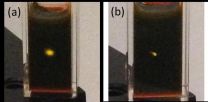(Press-News.org) Diseases like Alzheimer's are caused when proteins aggregate and clump together. In a world first, EPFL scientists have successfully distinguished between the disease-causing aggregation forms of proteins. The finding can help change pharmaceutical treatment of neurodegenerative diseases.
Because of our increasing lifespan, diseases like Parkinson's, Huntington's and Alzheimer's are on the rise. They are caused when certain proteins misfold and aggregate together, forming clumps that damage neurons in the brain and spinal cord. This aggregation evolves progressively through different forms, which could hold the key to treating the diseases they cause. However, current imaging techniques have not been able to distinguish and study each aggregation form separately. Combining two advanced imaging techniques, EPFL scientists have successfully distinguished the different aggregation forms of a protein involved in spinocerebellar ataxia, which affects motor control and coordination. Published in Nature Communications, the work also reveals a surprising twist in protein aggregation, and can be extended to other diseases as well.
Aggregated problems
Before aggregating, single proteins misfold into anti-parallel or criss-crossed weave patterns. The misfolded proteins then begin to aggregate through intermediate form, ultimately growing into large stringy tangles called "fibrils". By this point, the aggregation has become lethal to the cells.
These protein aggregates are the focus of medical research in neurodegenerative diseases, including Parkinson's, Huntington's and Alzheimer's. The focus is on distinguishing between the individual aggregation form of the proteins, in order to identify which ones we can target more effectively to treat the diseases. However, current imaging techniques have not been able to distinguish between a protein's intermediate species and the final fibrils.
Untangling the knots
The lab of Giovanni Dietler at EPFL addressed the problem by combining two imaging techniques. The first, Atomic Force Microscopy, looks at the 3D structure and of each aggregation form, as well as its properties, e.g. stiffness. The second technique, Infrared Spectroscopy, detects the subtle changes that take place in the protein's structure that cause and drive its aggregation.
"These two techniques are very useful," says Dietler. "But individually, they cannot pinpoint the moment that the protein begins to misfold or find how the protein's structural properties relate to the structure of a particular aggregation form." Both these elements are critical in distinguishing different aggregation species. Together, the two techniques comprise an innovative tool known as "Infrared Nanospectroscopy", or nanoIR, which Dietler's lab spearheads in a range of applications.
In this case, the scientists focused on the protein ataxin-3. When it mutates, ataxin-3 begins to aggregate and form fibrils with devastating consequences on motor control and coordination. This neurodegenerative disease is known as spinocerebellar ataxia.
Using nanoIR, the EPFL researchers were able to monitor the evolution of individual ataxin-3 proteins as they aggregated. They looked at the stiffness of individual aggregated forms and then linked it to the number of weave patterns that they contained, providing a correlation between the two factors. It is the first time this has been done for individual aggregation forms.
A surprising twist
To their surprise, the nanoIR approach showed that ataxin-3 misfold after it aggregates, not before as would be expected by current views on aggregation. In fact, the aggregation of ataxin-3 seems to begin with the individual protein, and then moves onto the formation of intermediate aggregation forms with the original protein structure rather than a misfolded one.
There are significant medical and scientific implications of this finding. It finally confirms previous theories about protein misfolding that could not be tested due to the limitations of available techniques. At the same time it could change pharmacological and technological approaches to protein aggregation.
The study also demonstrates the enormous potential of nanoIR in this area of research. "It can allow us to get a deeper understanding of protein aggregation," says Giovanni Dietler.
INFORMATION:
This work was supported by the Swiss National Foundation for Science and the Medical Research Council (UK).
Reference
Ruggeri FS, Longo G, Faggiano S, Lipiec E, Pastore A, Dietler G. Infrared nanospectroscopy characterization of oligomeric and fibrillar aggregates during amyloid formation. Nature Communications 28 July 2015. DOI: 10.1038/ncomms8831
PITTSBURGH, July 28, 2015 - By studying the yeast used in beer- and bread-making, researchers at the University of Pittsburgh School of Medicine have uncovered the mechanism by which ancient proteins repair DNA damage and how their dysfunction could lead to the development of tumors. The findings, published online today in Nature Communications, could lead to new ways to tailor cancer therapies.
In humans, protein mutations called RAD51 paralogues have been associated with breast and ovarian tumors, said senior investigator Kara Bernstein, Ph.D., assistant professor of ...
DURHAM, N.C. -- The light-sensing molecules that tell plants whether to germinate, when to flower and which direction to grow were inherited millions of years ago from ancient algae, finds a new study from Duke University.
The findings are some of the strongest evidence yet refuting the prevailing idea that the ancestors of early plants got the red light sensors that helped them move from water to land by engulfing light-sensing bacteria, the researchers say.
The results appear online in Nature Communications.
"Much like we see the world through our eyes, plants 'see' ...
OAK BROOK, Ill. - Specific cardiovascular risk factors, such as alcohol consumption, smoking, obesity and diabetes, are associated with smaller regional brain volumes that may be early indicators of Alzheimer's disease and dementia according to a study published online in the journal Radiology.
"We already know that vascular risk factors damage the brain and can result in cognitive impairment," said Kevin S. King, M.D., assistant professor of radiology at the Keck School of Medicine of the University of Southern California in Los Angeles. "But our findings give us a more ...
Adding omega-3 fatty acids to anti-tumor medications may improve treatment response and quality of life for cancer patients according to a new study by researchers at the University Hospitals of Leicester in the United Kingdom.
The study, published today in the OnlineFirst version of the Journal of Parenteral and Enteral Nutrition (JPEN), the research journal of the American Society for Parenteral and Enteral Nutrition (A.S.P.E.N.), examined 50 patients with advanced pancreatic cancer.
Patients were given 1,000 mg of gemcitabine weekly followed by up to 100 g of omega-3 ...
A new study finds that exogenous glucagon-like peptide 2 (GLP-2) treatment may help fight neonatal parenteral nutrition-associated liver disease (PNALD).
The study, published today in the OnlineFirst version of the Journal of Parenteral and Enteral Nutrition (JPEN), the research journal of the American Society for Parenteral and Enteral Nutrition (A.S.P.E.N.), provided neonatal piglets with 17 days of parenteral nutrition therapy and either GLP-2 treatment or saline control. In a previous study, the researchers found that GLP-2 therapy improved bile flow and serum markers ...
Babies born very premature or severely underweight are at heightened risk of becoming introverted, neurotic, and risk averse as adults, indicates research published online in the Archives of Disease in Childhood (Fetal & Neonatal Edition).
This personality profile may help to explain the higher rates of career and relationship difficulties experienced by this group as adults, suggest the researchers.
Very premature birth at less than 32 weeks and/or very low birthweight of less than 1500 g are known to be linked to a heightened risk of autistic spectrum behaviours, ...
Depression and personality disorders are the most common diagnoses among Belgian psychiatric patients requesting help to die, on the grounds of unbearable suffering, finds research published in the online journal BMJ Open.
Drugs, given either by mouth or administered intravenously, are used to perform euthanasia in Belgium, where the practice has been legal since 2002.
The researchers wanted to find out if there were any discernible patterns in requests for euthanasia among mentally ill patients in Belgium in a bid to inform recommendations for future research.
So ...
1. Placebo delivery method affects patient response to "therapy"
Free abstract: http://www.annals.org/article.aspx?doi=10.7326/M15-0623
URLs go live when embargo lifts
A systematic evidence review published in Annals of Internal Medicine finds that the way in which a placebo is delivered makes a difference in how patients respond to "therapy." Having a clinically significant response to the sham treatment could substantially affect outcomes in placebo-controlled trials. The data suggests that some placebos have a stronger effect than others.
Placebo controls, ...
The University of Colorado Cancer Center and Loxo Oncology, Inc. (Nasdaq:LOXO), a biopharmaceutical company focused on the discovery, development and commercialization of targeted cancer therapies, today announced the publication of a research brief in the online edition of the journal Cancer Discovery, describing the first patient with a tropomyosin receptor kinase (TRK) fusion cancer enrolled in the Phase 1 dose escalation trial of LOXO-101, the only selective TRK inhibitor in clinical development. Additional contributors to the paper include the Knight Cancer Institute ...
RIVERSIDE, Calif. -- When it comes to installing solar cells, labor cost and the cost of the land to house them constitute the bulk of the expense. The solar cells -- made often of silicon or cadmium telluride -- rarely cost more than 20 percent of the total cost. Solar energy could be made cheaper if less land had to be purchased to accommodate solar panels, best achieved if each solar cell could be coaxed to generate more power.
A huge gain in this direction has now been made by a team of chemists at the University of California, Riverside that has found an ingenious ...

